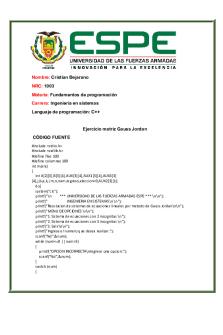Jordan 5+Rights+of+Clinical+Reasoning PDF

| Title | Jordan 5+Rights+of+Clinical+Reasoning |
|---|---|
| Author | Aaron Wilkerson |
| Course | Mental Health Experimental |
| Institution | Roseman University of Health Sciences |
| Pages | 2 |
| File Size | 164.4 KB |
| File Type | |
| Total Downloads | 89 |
| Total Views | 123 |
Summary
Case study assignments ...
Description
The FIVE Rights of Clinical Reasoning THINK Like a Nurse
1. RIGHT Cues. Identify and recognize what clinical data is relevant or most important. 2. RIGHT Patient. Is your patient high risk for a change in status due to age or being susceptible to infection? 3. RIGHT Time. EARLY recognition of worst possible/most likely complication. 4. RIGHT Action. Once a problem is identified, what nursing interventions must be initiated? 5. RIGHT Reason. Rationale for implementing nursing interventions when a problem is recognized.
1. RIGHT CUES. What clinical data (VS, assessment, labs) did you collect that is relevant or most important? RELEVANT Data: Clinical Significance: 18-year-old African-American Part of a culture that is harassed and discriminated against. Transgender History of MDD, suicidal ideation, and self-harm behaviors and has cut self repeatedly on left inner thigh using a metal tack
Patient has a history that contributes to further problems for the future.
Female at birth and identified as transgender at age 14
Part of discriminated against society
Mother died when he was infant, ward of state,
No social support system other than state
Insight and judgement are impaired
Describes self-harm as impulsive. Lacks impulse control
Suicidal ideation
Fear of worsening condition and suicide attempts as well as self-harm
2. RIGHT PATIENT. Is your patient high risk for a change in status because of age or being a susceptible host? The patient is high risk for change in status because of history of MDD, suicidal ideation, and self-harm
What is the worst possible/most likely complication(s) to anticipate based on the primary problem of your patient? SUICIDE 3. RIGHT TIME. What nursing assessments will identify this complication EARLY if it develops? Mental Health assessment and FICA assessment. Suicide assessment. 4. RIGHT ACTION. What nursing interventions will you initiate if this complication develops? Suicide precautions and 1:1 with medication prescriptions.
5. RIGHT REASON. What is the rationale for the interventions you identified? How will they make a difference? 3. Assessments to Identify EARLY: 4. Interventions to Rescue: 5. Rationale: Suicidal Ideation
Suicidal precautions with 1:1 observation. This would include taking dangerous things out the of room, checking the patient for dangerous things, as well as continual mental health assessments.
Because the patient is showing suicidal ideation, there is a risk for suicide and needs to have precautions implemented so that there is not a suicide or attempt that occurs.
FICA
Helping the client identify what is important to them and possible support groups that may be available. Getting them into groups and social supports.
This assessment helps to identify beliefs, support system, and other factors that would be helpful in order to deter the client from suicide and suicidal ideation.
Anxiety
Anxiety decreasing methods and coping mechanisms.
Anxiety is a contributing factor and trigger for the client and will worsen the suicidal ideation
MDD symptoms
Medication reconciliation as well as depression coping mechanisms.
MDD can exacerbate the suicidal ideation but also make it so they don’t have the energy to go through with the action.
© 2016 Keith Rischer/www.KeithRN.com Adapted from: Levett-Jones, T., Hoffman, K., Dempsey, J., Yeun-Sim Jeong, S., Noble, D., Norton, C. Hickey, N. (2010). The ‘five rights’ of clinical reasoning: An educational model to enhance nursing students’ ability to identify and manage clinically ‘at risk’ patients. Nurse Education Today...
Similar Free PDFs

R v Jordan - case
- 5 Pages

Formula sheet Jordan 7e
- 4 Pages

Método de Gauss-Jordan
- 8 Pages

Jordan Peterson and leadership
- 5 Pages

Metodo gauss jordan Matlab
- 4 Pages

Jordan SBAR Fillable PDF
- 1 Pages

SP21 Wills Jordan CH12 M
- 2 Pages

Summary. June Jordan revision
- 2 Pages

Jordan Fisher - ddh4ry3q4wo8t8y3w4t3
- 11 Pages

Ejercicio matriz Gauss Jordan
- 11 Pages

Marca Torres Jordan Oscar
- 4 Pages

Forma canonica di Jordan
- 4 Pages

Lab1-I-condori flores jordan
- 10 Pages
Popular Institutions
- Tinajero National High School - Annex
- Politeknik Caltex Riau
- Yokohama City University
- SGT University
- University of Al-Qadisiyah
- Divine Word College of Vigan
- Techniek College Rotterdam
- Universidade de Santiago
- Universiti Teknologi MARA Cawangan Johor Kampus Pasir Gudang
- Poltekkes Kemenkes Yogyakarta
- Baguio City National High School
- Colegio san marcos
- preparatoria uno
- Centro de Bachillerato Tecnológico Industrial y de Servicios No. 107
- Dalian Maritime University
- Quang Trung Secondary School
- Colegio Tecnológico en Informática
- Corporación Regional de Educación Superior
- Grupo CEDVA
- Dar Al Uloom University
- Centro de Estudios Preuniversitarios de la Universidad Nacional de Ingeniería
- 上智大学
- Aakash International School, Nuna Majara
- San Felipe Neri Catholic School
- Kang Chiao International School - New Taipei City
- Misamis Occidental National High School
- Institución Educativa Escuela Normal Juan Ladrilleros
- Kolehiyo ng Pantukan
- Batanes State College
- Instituto Continental
- Sekolah Menengah Kejuruan Kesehatan Kaltara (Tarakan)
- Colegio de La Inmaculada Concepcion - Cebu


